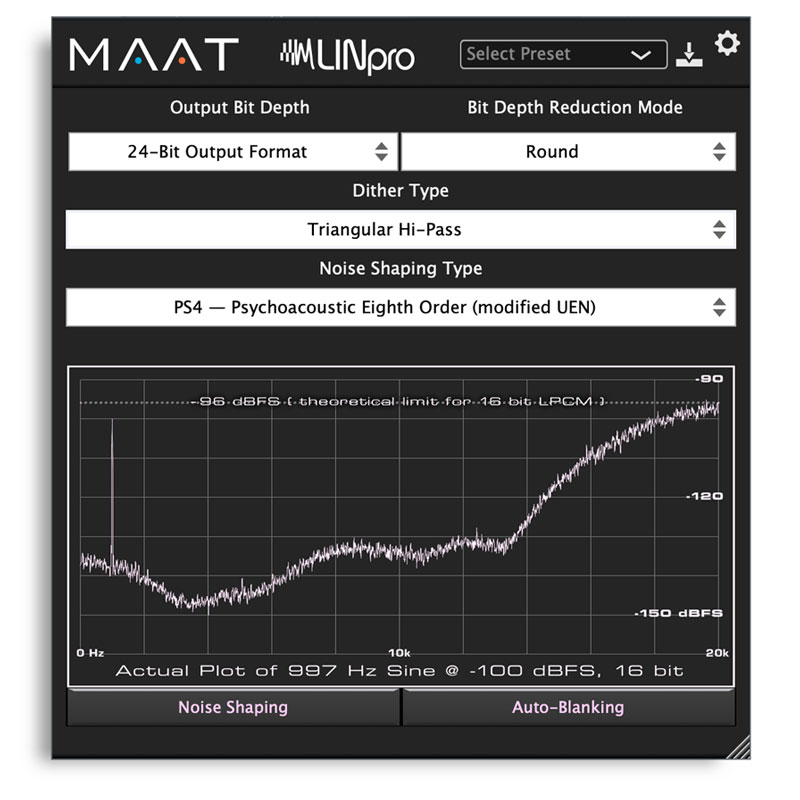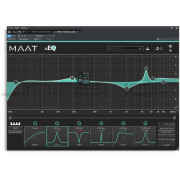You're currently on:
LIN Family — Advanced & Flexible Dither
Precision redithering…the missing links between distortion and definition.
LINSurround, LINpro & LINone :: Cross–platform Plug–ins
The LIN family is our rethinking of redithering.
LINSurround Price: $59 [multichannel]
LINpro Price: $39 [stereo]
LINone Price: $19 [stereo]
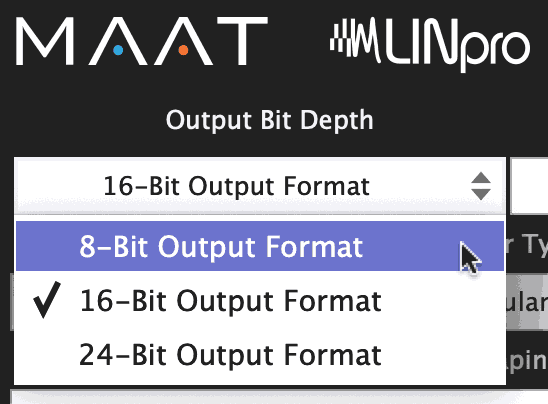
Your Sound, Your Way
Sharing the same user interface, MAAT’s two channel and multichannel LIN family are your final link between production and delivery. Offering optional word length reduction and seven noise shaping spectra tailored to both analog and digital delivery of assets, LIN is highly adjustable to help create your own signature “sound.” In addition to TPD and weighted TPD, LINpro and LINSurround feature four newly developed fifth, eighth and ninth order psychoacoustic noise shaping choices. As with all dithering mechanisms, LIN must be the very last plug–in instance, just prior to converting to the final, fixed–point format.
LINpro and LINSurround incorporate the latest advances in auditory and psychoacoustic research. Older, outdated dithering engines rely on decades–old approaches to the problem. We at MAAT evaluated our original LINearise engine and realized that we could “do it” even better, implementing a more accurate, mathematically superior approach plus new thinking on both the User Experience (UX) and how you want your master to sound. Whether you’re delivering a 16 bit Red Book dupe master, a 24 bit “high res” 88.2k file to today’s higher fidelity streaming services, or multichannel 48k stems for video and motion picture surround work, the LIN family will take you there with the best sounding tracks obtainable.
LINone — Essential Dithering At A Nice Price
Redithering with LINpro: highly adjustable, easy to use and versatile. Considering LINpro but just starting out? LINone is your easy to use, lower cost entry into a world of better delivery. LINone gives you the essentials; precision, 1st order noise shaped dithering for 16 or 24 bit delivery using LINpro’s superior, modern engine.
Need More?
LINpro and LINSurround have it. As you’d expect, automatic muting and variable bit depth, 16 or 24 bits, but also a choice of 8 bit output to instantly hear how your current choice “sounds.” In addition to Triangular Probability Density Function (TPDF) and High Passed TPDF, rectangular dither is also available for educational or experimental exploration.
Rounding performs fundamental linearization, what can be thought of as very low amplitude distortion reduction, by representing all former least significant bits with one single LSB in the resulting word length–reduced version. On the other hand, truncation does not preserve any of that low amplitude information. Instead, it’s just thrown away. LINpro and LINSurround are one of the only redithering products available that offers a choice between rounding and truncation.
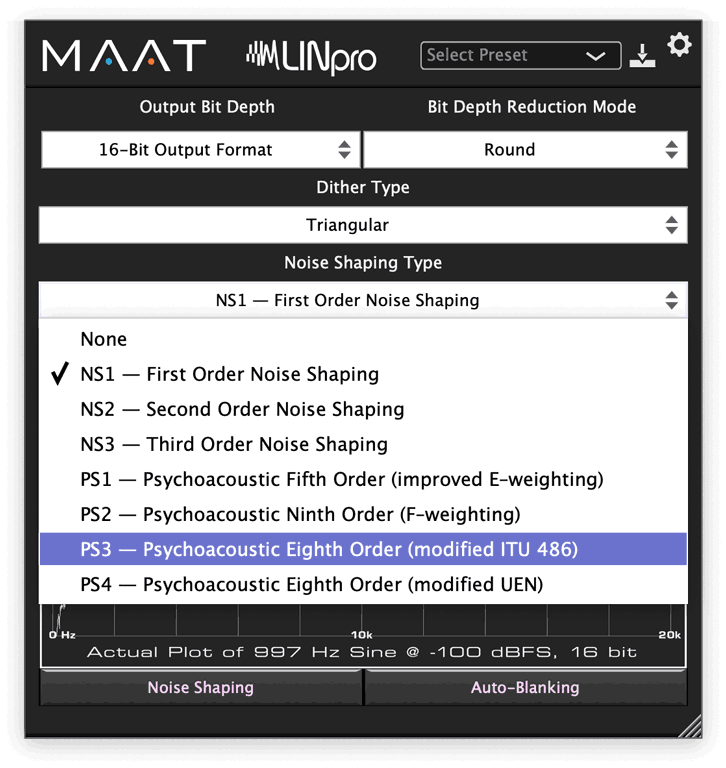
Eyes On It
LINpro and LINSurround bring visual certainty to the arcane art of dithering. We’ve included real world plots of each noise shape for your viewing pleasure. These are not MATLAB simulations, they are actual plots generated by LINpro’s optimized dither engine. Notice that the -100dBFS input signal, that spike at the left side of the plot, is preserved even though the word length has been reduced to 16 bits. A 16–bit word can only encode or store 96dB of dynamic range. Any information quieter than -96dBFS should be lost when reducing the word length to 16 bits. With LIN, up to the 19th bit of the input signal is preserved, embedded in the resulting 16–bit word.
Dither is a fundamental aspect of today’s DAWs. Although not usually thought of as such, re-dithering is important DSP (Digital Signal Processing). In the distant past, much of the pioneering research on dither was performed at Bell Labs. According to information theory, you should add a pinch of noise to your digital audio every time you alter it to keep it distortion–free and to preserve program content by embedding it in the noise floor. That’s dither. Use it to make your digital audio less…“digital!”
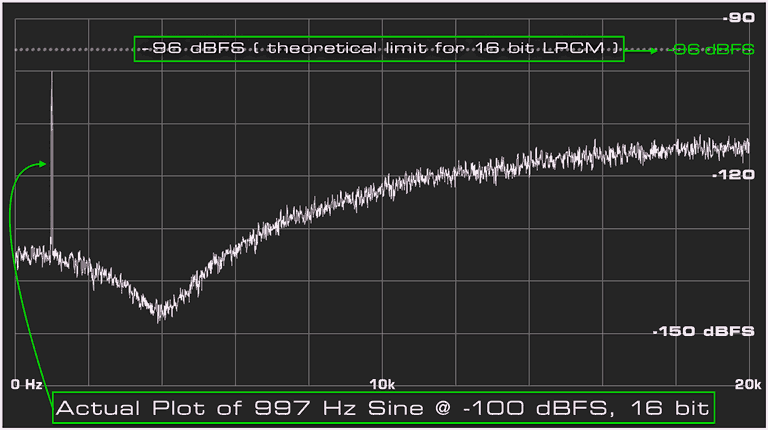
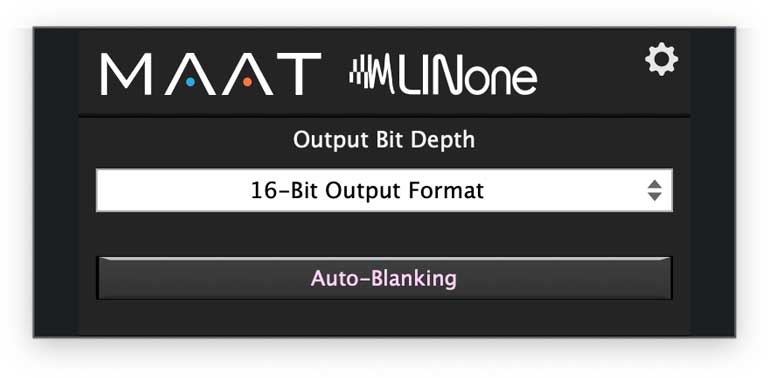
LINone — Your Low Cost Entry Into A More Linear World
LINone provides basic, high precision dithering at a price anyone can afford. Plus, LINone’s dither is more accurate and better sounding than the dither built into several popular DAWs. Compare LINone’s exacting action with your DAWs in–built dither. We think you’ll be surprised.
LINpro & LINSurround Product Features
Redithering…On Your Terms
LINpro works with either mono or stereo tracks, while LINSurround is channel count–agnostic. With LINSurround, up to 128 channels are supported.
Word Length Reduction
- Significant Bits: 24, 16, 8
- Round, Truncate
Spectrum & Weighting
- 1st Order Noise Shaping
- 2nd Order Noise Shaping
- 3rd Order Noise Shaping
- 5th Order Noise Shaping (improved E-weighting)
- 8th Order Noise Shaping (modified ITU 486)
- 8th Order Noise Shaping (modified UEN)
- 9th Order Noise Shaping (F-weighting)
Redithering
- Triangular, High Passed Triangular, Rectangular
- Noise Shaping Bypass/Defeat
- Auto–Blanking
LINone Product Features
Better Redithering On A Budget
LINone work with either mono or stereo tracks.
Word Length Reduction
- Significant Bits: 24, 16
Spectrum & Weighting
- 1st Order Noise Shaping
Redithering
- Triangular
- Auto–Blanking
Reviews & Testimonials
Timo Wildenhain — Head of Professional Audio at Steinberg Media Technologies GmbH
“We have chosen LINpro dithering for our high-end mastering software WaveLab Pro 11 because we didn't want to make any compromises regarding sound quality and ease of use. LIN is simply the best dithering on the market.”
Fredrik Kinbom – musician and indy engineer
“I have now done a shoot-out with the dithering in…(my previous favorite)…with the LINpro on various settings. I never thought the type of dithering could make much of a difference, that it was more like ‘make sure you use something good’. But I can hear (on my Audeze LCD-X cans) a clear positive difference - with your dithering the sound is more open, like a lid is lifted slightly and the sound widens a bit. On both noise shaped and non-noise shaped settings. It’s a few ‘millimetres’ of a difference but, in mastering, those millimetres are so important. Amazing! :-)”
Richy Hughes - Binary Feedback Mastering
“When I compared LINpro’s flat triangular and triangular high-pass to my usual dither options, I immediately felt that all elements of the sound picture were reassuringly ‘locked in’ with an effortlessly natural presentation to the music. In particular, the depth and physicality in the low mid and bass regions have to my ears been exceptionally well preserved.
I’m also both surprised and impressed by the shaped modes. With many other shaped dithers I’ve often had the feeling that it was adding subtle excitement or airy sheen to the perception of the sound, particularly when noise is heavily shifted towards the very top end. With MAAT’s shaped options, I felt very differently. Rather than seeming to gain a characteristic as such, with LINpro it felt more like I had a choice of precision audio lenses. With one of these in place, I was simply hearing certain areas of the mix presented to me with greater depth through the DAC. The different shapes can help me define the focal point of the dither within the mix. Of course, not every choice of ‘lens’ can be the correct one for every picture, but I often find myself returning to the 8th order options in favour of flat dither. They can help capture the sense of space in the mid–range, revealing a deeper and more richly textured background on the output, but without any feeling of misting or unwanted excitement elsewhere.
I also appreciate that rounding/truncation is performed inside the plugin itself, which gives me confidence that what I’m hearing on playback from the workstation translates to any fixed point offline rendered files.
I don’t believe that LINpro will replace my other options entirely, but it has in a very short time become my template starter for creating masters and subsequent deliverables. So far, it has not been removed in favour of anything else.”
R.S. - Indy engineer
“Just bought the LINpro dither stereo version because that 9th order psychoacoustic dither is one of the most transparent dithers I’ve heard in a long time. I had been using the Sonalksis Ultimate Dither plugin set for mastering and either acoustic or hybrid material (which I think can be better than what iZotope offers). But the 9th order dither with rounding for 24 bit audio at 96K (mixing down from 32 bit float) is incredibly natural sounding. I think it also beats out the old Apogee UV22 dither (which Logic no longer bundles but Steinberg Wavelab includes it). UV22 always seemed like it did something special (in a good way) to the low end, but sometimes at the expense of the midrange and high end. But (LINpro’s) psychoacoustic dither seems to just evenly affect the entire spectrum.”
Features
- Choice of 7 noise shapes
- Choice of 8, 16 or 24 bit words
- Choice of rounding or truncation
- 4 factory presets speed choice or customization
- Choice of TDF, HP TPDF or recatngular dither type
- Integrated, real world visual noise shaping plots
- Auto–blanking prevents “background” contamination
Supporting
- AAX Native (Pro Tools 10.3.10 and newer), AU, VST 2, VST 3
- Sample rates from 44.1 to 384 kHz
VST
VST PlugIn Interface Technology by Steinberg Media Technologies GmbH
License
- Perpetual: One–Time Buyout…
Requirements
- macOS 10.9 and newer, Universal Binary 2, 64 bit only
- Windows 7 and newer, 32 & 64 bit
| Variant | 1 |












